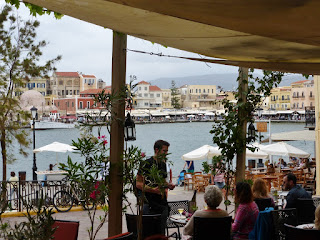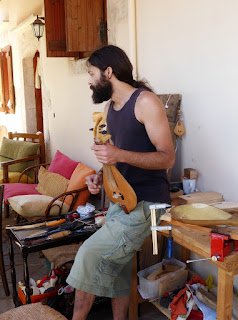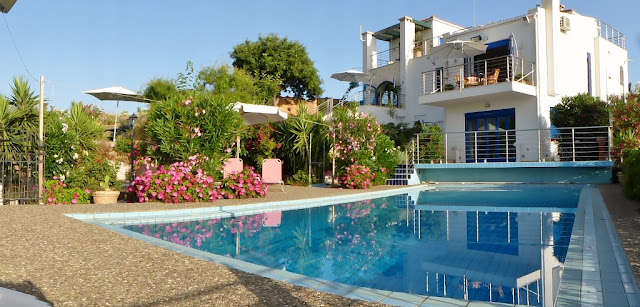From November thru January, nearly every Cretan will be out in their olive groves, harvesting olives! Its a common sight to come round a corner and find nets spread out over the road to catch the olives. And there’s the very distinctive noise of the rotary harvesting rakes - a sort of scratchy whine – you’ll need to come here to know what we mean!
So how do you tell what’s a good olive oil? Well, clearly you need to taste it! But you don’t need to see it – all that stuff
about its rich green colour (with one exception, see below) is just that, does
not mean anything about its taste, at professional tastings blue glasses are
used.
Here’s how to go about it:
- With a little oil in a small glass, warm it in one hand,
whilst closing the top of your glass with the other.
- Take a sip and aerate it in your mouth by drawing air in
between your lips – may need practise to avoid spilling it down your front! This should concentrate the aroma.
- Note the tastes, then swallow
- After swallowing a spicy burn should develop in your
throat – its like the finish in a wine.
After a few seconds this should die away again. If it lasts longer
this is a sign of poor quality.
The only instance when you should be careful of colour is if
you see a yellow Cretan olive oil. This
is a sign of degradation through exposure to light. A well-kept Cretan oil should be a deep
green. Olive oil is best kept in dark glass bottles out of sunlight
at an even temperature not over 20 deg. Plastic bottles may contaminate the oil
with plasticizers, and though metal tins are fine whilst unopened, afterwards
the metals may react with the oil.
Our Tasting Notes
Recently we visited Terra Creta, a producer with one of the most modern olive mills in Europe, based in Kolymbari, Crete. They have made this charming video which shows you how central the olive is to Cretan culture and life. We tried several of their olive oils, guided by Costas, the plant manager, and here are our impressions.
Recently we visited Terra Creta, a producer with one of the most modern olive mills in Europe, based in Kolymbari, Crete. They have made this charming video which shows you how central the olive is to Cretan culture and life. We tried several of their olive oils, guided by Costas, the plant manager, and here are our impressions.
PDO Kolymbari Extra
Virgin Olive Oil: grassy nose; mild taste, smooth on the palate and with very
little spiciness.
Terra Creta Biological
Olive Oil: stronger grassy nose and stronger grassy taste; much spicier
aftertaste this is caused by the polyphenols.
Terra Creta 0.2%
acidity Olive Oil: smoother texture; milder taste; spiciness develops slowly
in the mouth and then dies away. This
limited production is from olives harvested in November, at the beginning of the
harvest season. At this time the olives
yield less oil, but of a higher quality.
Cretans call the olive trees “the children of the earth”
- its in every Cretan’s blood and soul,
passed from one generation to the other.
Cretan olive oil is made from the Koroneiki olive, with a small
proportion of Tsunati. The latter is
typically used for eating, and has a fruitier taste but higher acidity. This enables Cretan olive oils to be anything
up to a medium fruitiness and spiciness.
You may have heard of “first cold pressing” being the best
olive oil. The maximum temperature for
cold pressing is 27 degrees done to preserve vitamins, (mainly E and A). After this pressing about 10% of the oil
remains in the olive pulp. This will typically
be extracted by a different process using heat and chemicals, which destroys
much of the benefits, but yields a very neutral and low acidity oil. Therefore low acidity is not necessarily a
measure of a good olive oil, but it is important for first cold pressed olive oil. To be “Extra Virgin” it must have acidity
less than 0.8% whilst “Virgin” olive oil can be up to 2% acidity.
 Olive oil
contains approximately 200 polyphenols which give the oil its spiciness and
bitterness, too much can affect taste; therefore it is necessary to get the amount
right! Many of these phenols have not
yet been fully explored.
Olive oil
contains approximately 200 polyphenols which give the oil its spiciness and
bitterness, too much can affect taste; therefore it is necessary to get the amount
right! Many of these phenols have not
yet been fully explored.
And olives age well! One
of the 10 oldest olive trees in the world is in VOUVES
in Crete. It was pretty old even when Christ was born, and may even have been
around when the Minoans were inhabiting their palaces!

Its important that the olives are processed as soon after picking as possible, and this explains why there are so many olive mills, almost literally dotted around each village. Each services their local area, and even larger producers like Terra Creta only take olives from their region.
At Panokosmos, we use the best olive oils, from a modern plant processing olives from local farmers.
If your interested we can set up a tour of Terra Creta in Kolymbari, which is less than an hour away.







































